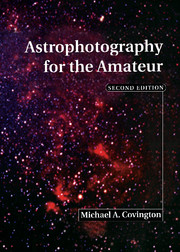7 - The solar system
Published online by Cambridge University Press: 05 September 2013
Summary
Amateur high-resolution photography of the sun, moon, and planets is a neglected field. I must confess to having neglected it myself, favoring wide-field deep-sky work like so many other amateurs. But high-resolution solar-system photography has several attractions. You can do it in town or even in a large city; you don't have to go elsewhere in search of dark skies. You don't have to wait for the moon to get out of the way; in fact, the moon is one of the targets. Perhaps more importantly, the appearance of the sun and many of the planets is constantly changing, so it's worthwhile to keep photographing the same object; the pictures stand a good chance of having scientific value.
With the advent of digital image enhancement – which often improves planetary pictures dramatically – and the publication of excellent handbooks by Dobbins, Parker, and Capen (1988) and Dragesco (1995), interest in the solar system may be reviving. This chapter will tell you how to get started with this rewarding kind of work.
Film or CCD?
The advent of CCD imaging has made it easier than ever for amateurs to obtain excellent images of the sun, moon, and planets. My first CCD image of Jupiter, taken with an 8-inch telescope, surpassed all my earlier photographs. There are several reasons for this. Unlike a conventional camera, a CCD does not produce any shutter vibration.
- Type
- Chapter
- Information
- Astrophotography for the Amateur , pp. 93 - 112Publisher: Cambridge University PressPrint publication year: 1999



